


SITE LOGIN
-
REVIEWS
- Ski Gear
- Clothing
- Accessories
- Off-Season Gear
- Lifestyle
- Lodges and Accommodation
- Nutrition
- Manufacturers
- Destinations
- Training
- Gear of the Year
- Best New Summer Gear
-
Holiday Gift Guide
-
Holiday Gift Guide 2024
- Holiday Gift Guide 2024 Base Layers
- MSR Explore Revo Snowshoes
- Fieldsheer Backcountry Heated Jacket
- Fieldsheer Premium 2.0 Merino Heated Socks
- MEC Hut Booties and Slippers
- Arc’teryx Kopec GTX Shoe
- Arc’teryx Kragg Insulated Approach Shoes
- Gregory Verte 18 Backpack
- Grundens Deck-Boss Ankle Boot
- MEC Northern Light Vest
- Montec-Scope-Ski-Goggles
- Mountain Hardware Kor Airshell Hoody
- Mountain Hardware Kor Alloy Crew
- Arcade Atlas Belt
- Dynafit Ridge Dynastretch Jacket
- Shokz OpenRun Pro 2 headphones
- Buff Merino Move Multifunctional Neckwear
- Bootdoc Foot Warmer
- Cotopaxi Allpa 42L Travel Pack
- DPS LastBag
- DPS PHANTOM Glide At-Home Kit
- DPS Mission Quiver Roller
- Dragon Amped sunglasses
- Dragon DX3 Plus OTG photochromic goggle
- Fuse Lenses Anclote Flashback
- Garmin Fenix 8 Solar Sapphire Watch
- Gregory Alpaca Gear Tote 30
- Hotronic Boot Dryer
- MEC Aluminum Pot Set
- Gnara Go There Pants
- Grundens Shackleton 2.0 Duffel
- Jones Deeper 19L Backpack
- Le Bent Core Midweight Crew base layer
- Leatherman ARC
- Montane Nordes Hooded Softshell Jacket and Pants
- Helly Hansen Odin Everdown Hooded Jacket
- Helly Hansen Verglas Infinity Shell Jacket 2.0
- Montec Fawk Ski Jacket
- Pomoca Free Pro 2.0 Skins
- Rab Glaceon Pro Down Jacket
- Rab Khroma Converge GORE-TEX Ski Jacket & Pants
- Smith Squad MAG Goggles
- Stellar Guide Aerogel Hybrid Hood 2.0
- Stellar Ultralight Down Hood 2.0
- Arms of Andes Alpaca Half Zip & Wool Leggings
- Cotopaxi Allpa 70L Duffel Bag
- Giro Taggert Mips Helmet
- Loonr Hi Flyer Boots
- Paka Mountain Crew
- Roll Recovery SUPERPLUSH Classic Shoes
- Smartwool Smartloft Hooded Jacket and Pants
- Ortovox Switchback 32 Ski Touring Backpack
- Cotopaxi Allpa X 3L Hip Pack
- Giro Sagen Ski Goggle
- Icebreaker Ski+ Over the Calf Socks
- MEC-Fireside-Fleece-Snap-Pullover
- Montec Roast Mittens
- Mountain-Hardware-Sunblocker-Hoody
- MSR Titan Kettle 900 ml
- Tailgate-Industries-The Gondom-Goggle-Cover
- Wild Country Rope Tarp
- Bootdoc Race Merino PFI 50 Socks
- Remind Soles Destin Impact Insoles
- Kari Traa Rose Baselayer Half Zip Top and Pants
- Le Bent Midweight Quarter Zip
- Ombraz Dolomite Sunglasses
- Ortovox Fleece Rib Hoody
- Ortovox Merino Thermovent Base Layer
- Smartwool Intraknit Merino Tech Half Zip
- Suunto Wing Bone Conduction headphones
- Sweet Protection Adapter Mips Helmet
- Sweet Protection Connor Rig Reflect Goggles
- Zeal Optics Selkirk Glacier Glasses
- Norrona more flex1 Pants
- Norrona Octa Zip Hood
- Norrona Lyngen Alpha100 Zip Hood
- MEC Deluxe Pillow
- Holiday Gift Guide 2023
- Holiday Gift Guide 2022
- Holiday Gift Guide 2021
- Holiday Gift Guide 2020
- Holiday Gift Guide 2019
- Holiday Gift Guide 2018
- Holiday Gift Guide 2017
- Holiday Gift Guide 2016
-
Holiday Gift Guide 2024
- Pro Skier Interviews
- NEWS
- STORE
- ROUTES
- LODGING
-
VIDEOS
- 2022/23 Gear Reviews
- 2021/22 Gear Reviews
- 2020/21 Gear Reviews
- 2019/20 Gear Reviews
- 2018/19 Gear Reviews
- 2017/18 Gear Reviews
- 2016/17 Gear Reviews
- 2015/16 Gear Reviews
- 2014/15 Gear Reviews
- 2013/14 Gear Reviews
- 2012/13 Gear Reviews
- 2011/12 Gear Reviews
- 2020 Outdoor Retailer
- 2019 Outdoor Retailer
- 2018 Outdoor Retailer
- 2017 Outdoor Presscamp
- 2017 Outdoor Retailer
- 2016 Outdoor Presscamp
- 2016 Outdoor Retailer
- 2015 SIA Show
- 2014 Outdoor Retailer
- 2013 SIA Show
- 2012 Outdoor Retailer
- Tips and Tricks
- Backcountry Skiing
- SAFETY
- ABOUT
- REVIEWS
- NEWS
- STORE
- ROUTES
- LODGING
-
VIDEOS
- 2022/23 Gear Reviews
- 2021/22 Gear Reviews
- 2020/21 Gear Reviews
- 2019/20 Gear Reviews
- 2018/19 Gear Reviews
- 2017/18 Gear Reviews
- 2016/17 Gear Reviews
- 2015/16 Gear Reviews
- 2014/15 Gear Reviews
- 2013/14 Gear Reviews
- 2012/13 Gear Reviews
- 2011/12 Gear Reviews
- 2020 Outdoor Retailer
- 2019 Outdoor Retailer
- 2018 Outdoor Retailer
- 2017 Outdoor Presscamp
- 2017 Outdoor Retailer
- 2016 Outdoor Presscamp
- 2016 Outdoor Retailer
- 2015 SIA Show
- 2014 Outdoor Retailer
- 2013 SIA Show
- 2012 Outdoor Retailer
- Tips and Tricks
- Backcountry Skiing
- SAFETY
- ABOUT
TOP VIDEOS
Fischer TransALP Boots
 Fischer has been a staple visit on my trade show circuit each winter and this year at SIA they unveiled not just the innovative PROFOIL climbing skin but also a new alpine touring (AT) boot in the Fischer TransALP line up. It’s called the Fischer Transalp Thermoshape. The Thermoshape differs from the current Transalp Vacuum TS and Vacuum TS Lite in a few ways. To start with it’s a few hundred dollars cheaper than both the Vacuum versions, always a plus! While the fit may not be as adaptable as the Vacuum version the Transalp Thermoshape boots do have a thermoformable Ultralon boot liner so they’re customize to your foot similar to most other alpine touring boots. The big difference with the Fischer Vacuum technology is that it actually molds the shell up to 5mm on either side so you get a full 10mm of customization, but as I said in the lead in, this will cost you. While I have never experienced being fit for a pair of Fischer Vacuum Boots, the concept sounds like an effective one. I can however comment on the out of box fit of the Transalp Thermoshape Boots. While not perfect I was surprised at how well they fit my (average) foot and the fact that they provided a larger than average toe box meant that my feet and especially my toes stayed warm on those colder ski days. The initial modification prior to heat moulding the liners was to take out the stock foot beds and replace them with my SIDA custom foot beds. The stock footbeds are where boot manufactures can save some money and hence they offer little to no support. If you really want to get a performance out of a ski boot and as solid a fit as you can then a proper foot bed is highly recommended and well worth the investment for any ski boot.
Fischer has been a staple visit on my trade show circuit each winter and this year at SIA they unveiled not just the innovative PROFOIL climbing skin but also a new alpine touring (AT) boot in the Fischer TransALP line up. It’s called the Fischer Transalp Thermoshape. The Thermoshape differs from the current Transalp Vacuum TS and Vacuum TS Lite in a few ways. To start with it’s a few hundred dollars cheaper than both the Vacuum versions, always a plus! While the fit may not be as adaptable as the Vacuum version the Transalp Thermoshape boots do have a thermoformable Ultralon boot liner so they’re customize to your foot similar to most other alpine touring boots. The big difference with the Fischer Vacuum technology is that it actually molds the shell up to 5mm on either side so you get a full 10mm of customization, but as I said in the lead in, this will cost you. While I have never experienced being fit for a pair of Fischer Vacuum Boots, the concept sounds like an effective one. I can however comment on the out of box fit of the Transalp Thermoshape Boots. While not perfect I was surprised at how well they fit my (average) foot and the fact that they provided a larger than average toe box meant that my feet and especially my toes stayed warm on those colder ski days. The initial modification prior to heat moulding the liners was to take out the stock foot beds and replace them with my SIDA custom foot beds. The stock footbeds are where boot manufactures can save some money and hence they offer little to no support. If you really want to get a performance out of a ski boot and as solid a fit as you can then a proper foot bed is highly recommended and well worth the investment for any ski boot.

Comfort aside, the Fischer Transalp Thermoshape Boots offered a lightweight AT experience on the uptrack coming in at just 3440g which is on the lower end of the scales for AT boots. If you go for the Vacuum TS Boots you’ll save 200 grams and upgrading to the Transalp Vacuum TS Lite Boots you’ll save an additional 140 grams. While the Fischer Transalp Boots don’t set any weight records they do come pretty close in the cuff rotation department. With 53° range of motion (18° back and 35° front) these are one easy walking boot. In order to get the full benefit you do have to undo the top buckle and the power strap and of course switch them into ‘Hike’ mode.
The Transalp Thermoshape Boots also come with tech fittings built it. The bonus here is that there are indicators over the toe fittings to help you guide the tech pins into position - a really nice feature that makes transitions so much easier—especially for beginners.
Lets to a 360° shall we?
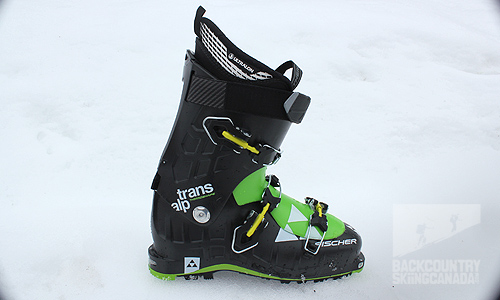
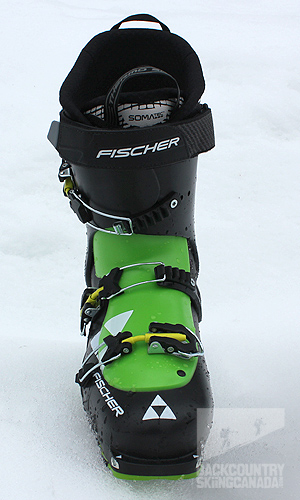


Features:
BOOT LINER
- Ultralon Padding
- Motion Support Liner
- Lace Liner
- Loop Tongue
- Full Thermofit

SHELL
- Adjustable Spoiler
- Hike Lock Mode
- Maximum Power Transfer
- On Center Position
- Original V-Position
Tech toes and hike/walk mode are standard issue on the trtansalp Boots.
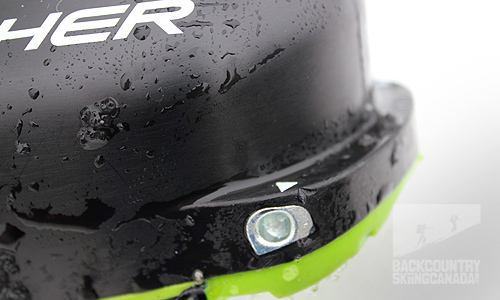

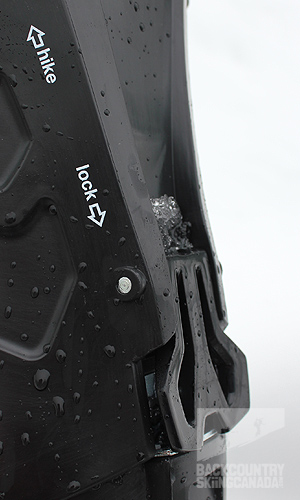
BUCKLES/VELCRO
- X-Light
- Touring Strap 40mm
Micro buckles are light and lay flat and out of the way when engaged.
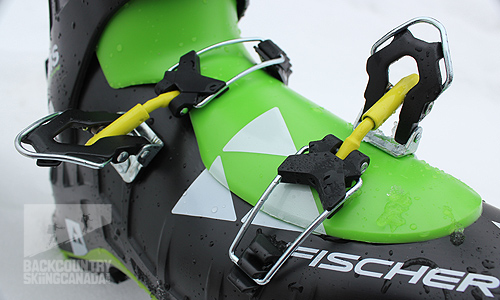
A top buckle hanger for touring mode, should you choose.
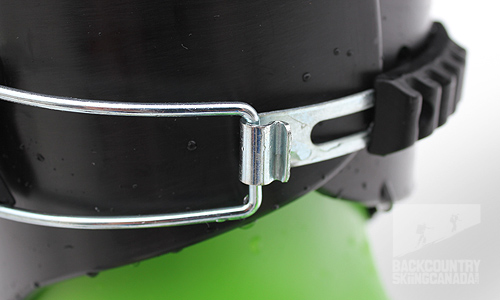
Three buckles are all you need when they are located properly on the shell as is the case here.
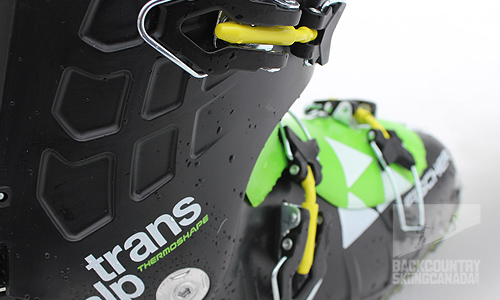
Verdict:
Since the 2014/15 season has not been bountiful with snow I ran the Fischer Transalp Thermoshape Boots mostly on resort and harder packed backcountry side trips (I am still holding my breath that more snow is coming). It was evident that this is a boot that can confidently ski the resort and tours just as well. Given that there’s only three buckles it does an admirable job keeping my foot snug and my heel down where it belongs. The middle buckle is located across the top arch of the foot where it’s most effective and there is really no need for a fourth buckle. Given that they have an unofficial flex rating of 110 (since Fischer does not assign flex ratings) I found the boots on the soft side but that is typically my preference since I am no longer a fast charging, 20 year old. Double that… and then some. While the flex was soft I did find it very progressive which I also prefer as it’s prudent insurance against shin bang. I think part of the reason that the Fischer Transalp Thermoshape Boots feel softer than a 110 rating (again these are subjective ratings) is that the cuff height is much lower than other AT boots I have tested. While this provides a nice progressive flex it did challenge me when driving a fatter ski in variable conditions. I found that I had to re-program my skiing style to be a little more back and slightly more ‘on my game’ otherwise I would end up front seating it on occasion. While this is not a game ender for the Transalp it is something to take note of if you prefer a stiffer ride or more support in the cuff. After a few days lapping the resort I was more than comfortable with the flex and cuff height. I also found this to be a positive attribute when on the skin track as it felt I had more natural forward flex in the boot—a huge plus since you spend 90% of the day walking up and not skiing down.
The only other item that I found had a bit of a functional learning curve was the top buckle. When I used the last position on the top buckle I found that the wire latch was not quite long enough to make the reach without hitting up against the buckle itself. This was problematic until I simply moved the buckle closer to the wire latch so that I no longer had to use the last position and the problem was solved. Also located on the top buckle is a metal loop hanger to catch the wire latch when you are in climbing mode. While a good idea in theory I found that I did not use this feature and it simply got in the way.
Due to the overlap of the Polyurethane (PU) plastic I found it difficult to get the liners back into the shells after drying them. I would expect this to get easier as the plastic gets older and the user has more practice but it could be an obstacle to those would already tend to not dry their liners. Once the liners were in place and the foot beds swapped out the Translaps provided a warm and comfy environment for my feet while skiing. The huge toe box as mentioned before also had a positive impact on keeping my toes warm and the freedom to wiggle when they wanted to. While Intuition liners and Vibram soles are always on my wish list for any boots the thermoformable Ultralon boot liners that come with the Fischer Transalp Boots kept me happy as did the grippy soles.
One really handy feature of the Transalp boots is that they come with tech toe fittings, a must have for any serious backcountry skier. The added bonus, however, is that they have small indicators silk screened over the top of the fittings to show you where to line up the tech pins. This makes things much easier and efficient on transitions and for those new to the tech world.
Overall the Fischer Transalp Thermoshape Boots are a solid choice at a reasonable price. If you are already a Fischer Boot user it’s likely an easy choice, if not, give them a try and see what you’ve been missing.
SPECS:
Price: $700 US
Weight: 3440g / 7.6 lb
Sizes: 23.5, 24.5, 25.5, 26.5, 27.5, 28.5, 29.5, 30.5
Colour: Black/Black/Green
Last: 102mm
Flex Rating: 110 (unofficially)
PROS:
- Light weight
- Progressive flex so no shin bang
- Comfortable liners with huge toe box
- Tech toe fitting alignment indicators
CONS:
- Hard to get liners back into shells
- Hike/Lock lever on spine is not that easy to grasp with gloves on
- Lower than average cuff height does not provide as much support as other boots do
- Noisy flex when you walk in them
Rating: 8.5/10
Fit/Comfort 2/2
Cuff Rotation 1.5/2
Function 1.5/2
Weight 2/2
Quality / Price 1.5/2
This is only our opinion. Do you disagree? Did we miss something? Are we totally out to lunch? Join the discussion in the forums here, and let us know what you think. People like/dislike gear for different reasons so chime in and we'll get a well-rounded evaluation.
Back to the rest of the reviews.
Copyright © 2023-24 Backcountry Skiing Canada. All Rights Reserved.







